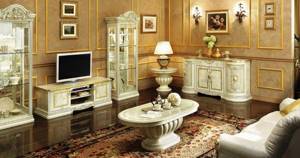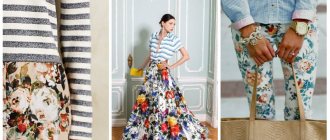A combination of luxury and simplicity
The concept of “purism” comes from the French word “purisme”, which means “striving for perfection”. In English and German, “pure” is translated as “precise, flawless, true.” The designation purism regarding architecture was first used by Le Corbusier in 1918. Later, this term began to be used when describing the style of furniture, and already in the second half of the 20th century, the expression was firmly entrenched in the vocabulary of interior designers. Purism appeared as an alternative to the rather boring ascetic, rational minimalism, “sterile” and cold high-tech. People wanted to “breathe life” into the interior, add luxury and sophistication, functionality and comfort. At the same time, it was important to preserve the atmosphere of lightness and simplicity of form. Purism, like a wealthy aristocrat, with all its generosity, hides money rather than displaying it. Behind the external restraint in such an environment are hidden expensive materials, exceptional quality decor, and designer items. This is a style for people with subtle innate taste and high social status. This “genre” has several distinctive features. One of them is the use of natural materials: wood, stone, leather, fur, etc. Plastic and metal are only possible in fragments in minimal quantities. Animal skins on the floor will fit the theme. A fireplace will also “fit” well into such an atmosphere. Marble or solid oak will look authentic on the floor. On the walls, brickwork and decorative plaster are equally possible. Complex ornaments and textured reliefs are not the strong point of purism. You will not find intricate figurines here. Paintings are rarely used. Purity of lines and forms is another characteristic feature of purism. All furnishings should be functional, practical and comfortable. As for colors, purist interiors use deep, clean, natural colors. If you remember that you have seen some colors in nature. use them. Bright, flashy, “acid” shades are prohibited in such an interior. A puristic interior does not get bogged down in details, but requires close attention to these very little things. The decor here must be carefully thought out. If you suffer from “souvenir mania” or your friends love “memento” gifts, then the work of a professional designer on your home will quickly “come to naught” and the house will turn into an example of eclecticism. This direction allows and even welcomes the use of innovation. When choosing technical “stuffing” for your home, delve into the latest inventions of the world's leading brands. Purism, in contrast to minimalism, which was intended as a design option for small apartments, is also suitable for spacious rooms. It is better to entrust interior design in the purist style to professionals. In Ukraine there are few studios working in this direction. And this is good. Because, in this way, one can say that “natural selection” has occurred in the market. Existing bureaus can safely be called pioneers, looking to the future, keeping their finger on the pulse of interior fashion. Companies that are unsure of their abilities will not set out to “tread down” the path, but will go along the already thoroughly laid “asphalted” road. If you dare to independently arrange your own purist space, have a good understanding of the style. Please note that there are many subtleties and nuances in this direction. This is not baroque, where excess is good. In a purist atmosphere, the most important thing is to maintain a balance: not to overdo it and not to be greedy. Because a step to the left is already minimalism, and a step to the right is avant-garde.
Design studio Ruslan Kovalchuk
The main features of purism: · Eco-friendly materials · Natural colors · Functionality · Purity and simplicity of lines and shapes
The paparazzi continue to pursue Angelina Jolie, speculating on the topic of her thinness and mental state, but the actress tries not to pay attention to them and continues to go about her usual business. She does this in a very beautiful and elegant way. So, the last pictures of Jolie were taken during her Sunday walk with her son Madox, and she was dressed like a true lady of the 1950s - a beige total look consisting of a bustier dress and a cashmere stole, large glasses with metal frames and Celine bags with a rigid shape and short handles.
This image is an ideal illustration of the actress’s new style, which Western journalists call the phrase luxe purism. It is based on discreet and discreet clothing without unnecessary details. Purism is distinguished by aesthetic clarity, emphasized simplicity and functionality, but it is this style that makes the greatest demands on the quality of things. The fabrics here must be of the best quality and the fit perfect. The slightest flaws will be visible instantly.
These are the images that Angelina Jolie has been increasingly choosing lately. While critics believed that she was going through a difficult divorce and therefore began to dress boringly, fashion insiders saw the actress’s gray, black, beige and white looks as the best example of modern purism or luxe purism. Her wardrobe is now beyond seasonal trends, and all the things in it are easily combined with each other.
Purism became popular in the 1980s. His main fans then were young career women. They needed high-quality and understandable clothing that would not distract them from building a successful career. 30 years ago, this movement was led by the Italian Giorgio Armani with his trouser suits and exemplary dark blue shade, as well as the German Gilles Sander. Jolie, who raises six children alone, makes films and does charity work as a UN Goodwill Ambassador, also doesn't have time to change clothes several times a day, but doesn't want to be seen in a stretched T-shirt and old jeans. Purism helps her look appropriate wherever she goes.
Many girls who have no time to think about combining fashionable prints and experimenting with layering can adopt this style. Moreover, Angelina’s principle “Look simple, but expensive” is not always a matter of price. Her wardrobe includes both Max Mara camel coats and Uniqlo cashmere sweaters for a couple of tens of euros. And together they give working combinations for every day.
One of the main components of Angelina Jolie's wardrobe is skirts. She wears both classic pencils and slightly flared models. Most often, the actress combines silk blouses and nude pumps with them, which will be appropriate with absolutely any wardrobe.
In addition, purism is a way out for those who think about the ethical component and seek to reduce their consumption of clothing, because the fashion industry is the second largest pollutant of the environment.
What's great about classics is their timeless position in relation to other styles. New trends in the fashion world come, turn women’s heads, and soon go away, making way for the next trends and tendencies. Whether it’s the classic style of clothing - unlike its counterparts, it is so firmly entrenched in the fashion Olympus that no new trends can shake it.
Story
It is difficult to say exactly when the classical style of clothing was born, since it seems to exist outside the framework of a time and geographical paradigm. However, it can be said that its formation was largely influenced by British fashion, starting in the 17th century. The Puritan style, with its severity and minimalism, laid the foundations of the modern classical style. The emergence of the feminist movement also had an impact on the formation of the canons of classic fashion, because initially classical suits were worn exclusively by men. Such masters as Cristobal Balenciaga and Coco Chanel made their contribution to the formation of the postulates of classic style. The role of the latter is especially great: Mademoiselle Coco managed to become the queen of women's classics, and not a single female fashion designer has yet been able to challenge this title.
Despite the fact that the foundations of classical fashion are monolithic and unshakable, like granite, over time, some details still change. Fashion trends and new trends make their way into the realm of classics, preventing them from becoming ossified and outdated.
Creating a classic interior in various rooms
Classic is applicable to any room, which is a consequence of its special functionality. However, before creating such an interior, you should soberly assess the capabilities of your house or apartment. The classic style requires the room to have enough space and a configuration close to an ideal square. In small and narrow rooms it is almost impossible to create an authentic classic interior.
Living room
If you have a large living room, a classic style would be an ideal option for decorating this room. To create a formal and at the same time light interior, it is recommended to use light neutral shades of beige and light gray for wall decoration. The use of richer tones for wall decoration requires a fairly large area of the room, since dark shades visually reduce the space.
The living room is a place where you can give free rein to stucco decoration not only on the ceiling, but also on the walls. This splendor can be supported by a stylized fireplace with candelabra and richly decorated curtains.
To fill the room, you should choose a sofa and a couple of armchairs, a coffee table and, depending on the need for organizing storage, a chest of drawers or a sideboard. When choosing furniture, you can turn to antique dealers or look for classic models in stores specializing in solid wood furniture.
A living room in a classic style interior is a place for receiving guests, small talk and meetings. Symmetrically arranged upholstered furniture will accommodate guests and create a special atmosphere for communication.
Bedroom
The central element of a classic-style bedroom is, of course, the bed. It should be equipped with an elegant headboard; if desired and possible, various canopies are appropriate in this style. On both sides of the bed there are bedside tables with lamps. Opposite the bed there is a chest of drawers and a mirror above it.
You should create an atmosphere of intimacy and intimacy with the help of textiles. It is better to opt for discreet monochromatic shades of bed linen, blankets and bedspreads. An abundance of different pillows will add coziness to the room.
Children's
A classic children's room is an ideal place for raising and growing a child. The functionality of the style will be clear and pleasant to any child, and the absence of excessive decor and the restraint of the interior will not distract from play and study.
For a children's room, you should choose plain pastel shades for the walls, curtains and a chandelier that are more restrained in terms of decor. In this room you can move away from symmetry by adopting the basic principles of furniture arrangement in the room. So, a place for creativity or lessons is located near the window. Near it there is a place to store books, toys, and personal belongings of the child. The bed is placed in the far corner of the room; you should avoid organizing a sleeping place on the aisle.
You can decorate a classic children's room with stylized toys: vintage collectible dolls, cars, teddy bears.
Kitchen
Decorating a kitchen in a classic style means special attention to the decor of the furniture. Its facades should be decorated with imitation stucco; cabinets with glass inserts and open shelves for storing holiday dishes and decorative items are welcome.
Particular attention should be paid to household appliances. The modern market offers enough stylized equipment that fits perfectly into this style. You can also give preference to built-in models.
The center of the kitchen is the dining table. To follow the style, you should pay attention to round or oval tables made of solid wood, complete with carved chairs. You can decorate your dining space with fresh flowers and decorative compositions. It is advisable to use festive tablecloths and napkins.

Bathroom
The most difficult thing to follow is the classic style when decorating a bathroom. Wall decoration can imitate marble or other natural stone. The mirror must be in a rich frame.
Particular attention should be paid to the choice of plumbing fixtures: stylized faucets, laconic sinks and bathtubs. If you have space, you should place a wrought-iron shelving unit, live plants, and even an ottoman in the room. This will create an atmosphere of luxury and comfort.
Creating a classic style requires not only good taste, but also quite a large investment. However, they pay off with the enduring relevance of this style and the high quality of those objects that make up its essence.
Classic clothing style: what is it based on?
The classical style has come a long way, during which it has managed to become truly exemplary (by the way, the word “classic” comes from the Latin “classicus,” which is precisely translated as “exemplary”). It is based on the following principles:
- elegance;
- harmony;
- proportionality;
- restraint;
- self-esteem;
- lack of trendy details, silhouettes, colors;
- functionality;
- knowing of limits;
- severity;
- femininity.
Classic style is often mixed with business style. These two directions do have common features, but they are not identical concepts. The business style simply inherited the features of the classic style, as it is associated with success, good manners, impeccable manners and similar taste. Proof of this is the immortal images in which the world remembers Coco Chanel, Audrey Hepburn, Grace Kelly, Jacqueline Kennedy, Margaret Thatcher.
Style accessories
An important part of the interior is all kinds of accessories. They should be unusual, emphasize the interior design, and attract attention. Many countries offer their own unique products for which they are famous. You can purchase beautiful Murano glass items made in Italy, Czech Bohemian glass, high-quality accessories from the UK and Germany. However, it is not necessary to purchase exclusively expensive things. They just need to fit into the environment.

It is important that the items are not only original, but also functional. So, a soft ottoman will not only be an addition, but also a place to relax. Rugs, original pillows, originally designed clocks, night lights, and figurines are good for the bedroom. In the kitchen these could be: unusual salt shakers, pepper shakers, various jars for spices, attractive bread bins. At the same time, you need to know when to stop so as not to clutter the room.
Before planning your design, look through photos of interiors decorated in a classic style or seek advice from professionals.
Photos and style examples
Main components
- The dress
is the foundation of the classic style in women's clothing. It can be very different - it all depends on the purpose, the figure of its owner and the purposes that the dress is intended to serve. The best option is a sheath dress that is knee-length or slightly lower. It is advisable that the color be restrained - black, blue, white, any of the pastel shades. Of the prints, only unobtrusive and discreet patterns are allowed - checks, thin stripes, small polka dots, chicken foot, herringbone. As for the length, it is dictated by the time of day and the purpose of the dress. So, for the first half of the day, a midi dress is suitable, while for an evening social event - a maxi-length model (unlike the daytime version, an evening dress made in a classic manner even includes slits and a neckline).
- Suit with trousers or skirt
. Simplicity rules the roost here. Both the lower part of the suit and the jacket should be made quite minimalistically, have a strict cut and fit perfectly. Pay attention to the material - tweed, thin wool, jersey are best suited for a classic suit, and in the summer version - linen.
- Blouse
. It can be moderately strict, moderately feminine, both tight-fitting and spacious (in this case, the blouse should be made of light materials such as chiffon or silk). The color of the blouse should be restrained and non-flashy.
- Shoes
. It may have a heel, but it should not be too high - up to 6-7 cm. Pumps, neat boots or ankle boots, without an abundance of flashy decor - this is what is useful for creating an image in a classic style. - Accessories
. There shouldn't be many of them. It is advisable that the jewelry be discreet, modest and not cheap. A string of pearls, a thin watch, an elegant strap, a silk scarf - all this can decorate its owner, who dresses a la classic.
Varieties of classic clothing styles
Some deviations from these rules are possible, and they are caused by the existence of varieties of the classical style.
Business style
This branch makes allowances for the peculiarities of office work: nothing should distract from it. Therefore, there is not even a hint of femininity: a minimum of details, an almost complete absence of decorative elements. Business style allows for a little more volume and borrowing from sports style. It retains elegance from the classic, while convenience is taken from the sporty. A loose raglan sleeve, a zipper, and buttons are the features that provide it. Under a suit, in addition to a straight-cut blouse, you can wear a turtleneck or a thin sports jumper. The skirt can be pleated or pleated.

Strict classic clothing style
Dandy style
He is characterized by the desire to show sophisticated chic in clothes. Every detail is carefully thought out. It was once a purely male trend in fashion, but over time it was adopted by women and underwent corresponding changes.
English style
This rather conservative and strict style demonstrates a deviation in the other direction compared to the classic business style of clothing. Here everything is even more limited to certain limits. The motto of this style is “Immaculate and Luxurious.” The British are a reserved people, not used to showing off their emotions. In addition, they are accustomed to approaching everything thoroughly, and not chasing short-term gain. Hence the commitment to time-tested traditions and laconicism in clothing. Blazers made in the English style should fit strictly to your figure. All components of the suit must be combined with each other not only in color, but also in the texture of the fabric. Fabrics are certainly expensive, natural. By the way, England has long been famous for its wool and the fabrics made from it - tweed, cashmere, drape, jersey.
Chanel style
It got its name from the world famous French designer Gabrielle (Coco) Chanel. Its characteristic features are elegant practicality and universal functionality. Coco Chanel freed women from long skirts that tangled in their legs, gave them trousers and a short haircut. The little black dress is an indispensable outfit in any situation - her invention. A Chanel suit emphasizes not only efficiency, but also femininity. It may contain some decorative elements: buttons stylized as gold and silver, a blouse collar tied with a bow, trim with braid, piping, cord or fringe, buckles, a belt with a chain.











